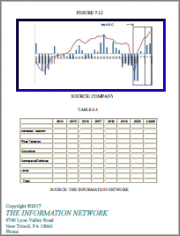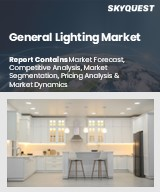
|
시장보고서
상품코드
1447049
세계의 파워 오버 이더넷(POE) LED 조명 시장 예측 : 와트수별, 부품별, 용도별, 최종 사용자별, 지역별 분석(-2030년)Power Over Ethernet (POE) LED Lighting Market Forecasts to 2030 - Global Analysis By Wattage (Up To 25 Watts and Above 25 Watts), Component, Application, End User and By Geography |
||||||
Stratistics MRC에 따르면, 세계의 POE(Power Over Ethernet) LED 조명 시장은 2023년 4억 560만 달러를 차지하였고, 2030년에는 11억 5,330만 달러에 이를 것으로 예측되고 있으며, 예측 기간 중 CAGR은 16.1%로 전망됩니다.
파워 오버 이더넷(POE) LED 조명은 단일 이더넷 케이블로 전력과 데이터를 모두 공급하여 조명에 혁명을 일으킵니다. 이 혁신적인 기술은 설치를 간소화하고 배선 복잡성을 줄이고 에너지 효율을 높입니다. 또한 조명의 밝기와 색상을 유연하게 조정할 수 있으므로 보다 적응성이 높은 지속 가능한 환경을 실현합니다. 스마트 빌딩 시스템에 원활하게 통합되는 기능을 갖춘 POE(Power Over Ethernet) LED 조명은 에너지 절약을 향상시킬 뿐만 아니라 다양한 상업 및 산업 용도에서 지능형 연결 조명 솔루션의 기반을 제공합니다.
간소화되고 비용 효율적인 설치로 에너지 효율 향상
에너지 효율성 향상과 간소화된 비용 효율적인 설치의 조합은 POE(Power Over Ethernet) LED 조명 시장에 큰 영향을 미칩니다. 기업은 에너지 소비를 줄이고 설치 프로세스를 간소화하여 운영 비용을 줄일 수 있는 POE 솔루션에 매력을 느낍니다. 이 이중의 장점은 지속가능성의 목표에 부응할 뿐만 아니라 POE(Power Over Ethernet) LED 조명의 경제적 매력을 높이고 업계 전반에 걸쳐 광범위한 채택을 추진하고 있습니다.
보안 우려
POE 네트워크에 잠재적인 취약점은 무단 액세스 및 사이버 위협으로 이어질 수 있으며, 널리 사용되는 데 방해가 됩니다. 데이터 유출 및 프라이버시 침해에 대한 우려는 POE(Power Over Ethernet) LED 조명 시스템에 대한 투자를 억제하고 시장 기세를 감속시킬 수 있습니다. 견고한 사이버 보안 대책을 수립하고 이러한 우려에 대처하는 것은 파워 오버 이더넷(POE) LED 조명 기술의 성공적인 통합을 위해 신뢰를 구축하고 안전한 환경을 조성하는 데 매우 중요합니다.
IoT와의 통합
파워 오버 이더넷(POE)과 사물 인터넷(IoT)의 통합은 LED 조명 시장에 변화를 가져옵니다. 이 시너지 효과는 스마트 조명 솔루션을 실현하고 연결성과 제어성을 촉진합니다. POE는 LED 장비 및 IoT 장비 간의 원활한 통신을 용이하게 하고 사용자에게 조명 시스템의 원격 관리와 최적화를 촉구합니다. 이 통합은 에너지 효율을 높일뿐만 아니라 스마트 빌딩과 도시의 진화를 지원하고 시장 성장을 가속합니다.
기술 표준 및 호환성
표준화된 프로토콜이 부족하면 상호 운용성 문제가 발생하여 서로 다른 POE 장치와 시스템 간의 원활한 통합을 제한합니다. 이러한 복잡성은 대중화를 방해하고 소비자와 기업은 기존 인프라와의 인터페이스가 쉽지 않은 기술에 대한 투자를 주저할 수 있습니다. 명확한 산업 표준이 존재하지 않기 때문에 불확실성이 생겨 기술 혁신이 저해되어 전력 절약 이더넷(POE) LED 조명 시장 전체의 성장이 둔화될 수 있습니다.
COVID-19의 영향
세계 공급망의 혼란, 건설 지연, 자본 지출 감소로 파워 오버 이더넷(POE) LED 조명 시스템의 채택이 지연되고 있습니다. 경기침체는 기업의 신중한 지출을 초래하여 에너지 효율적인 기술의 도입에 영향을 미치고 있습니다. 그러나 스마트하고 지속 가능한 솔루션이 중시되고, 경제의 완만한 회복과 함께 기업이 효율과 비용 절감을 우선하게 되어 파워 오버 이더넷(POE) LED 조명에 대한 관심이 다시 높아질 수 있습니다.
예측 기간 동안 전원 공급 장치 부문이 최대가 될 것으로 예상
POE 기술이 발전함에 따라 LED 조명 시스템의 전원 공급에는 효율적인 PSE 통합이 중요해지므로 전원 공급 장치 부문은 유리한 성장이 예상됩니다. 신뢰할 수 있는 PSE 솔루션은 에너지 공급, 확장성 및 전체 시스템 성능을 향상시킵니다. 시장 성장은 PSE의 기술 혁신에 달려 있으며 전력 공급 능력, 호환성, 비용 효율성 등의 요인에 영향을 미칩니다. 견고한 PSE 개발은 POE(Power Over Ethernet) LED 조명 채택을 촉진하고 기업 및 소비자에게 설치 복잡성을 줄여주는 지속 가능하고 유연한 조명 솔루션을 제공합니다.
데이터센터 부문이 예측 기간 동안 가장 높은 CAGR이 예상됩니다.
데이터센터 부문은 예측 기간 동안 CAGR이 가장 높을 것으로 예상됩니다. 이는 에너지 효율적인 솔루션에 대한 데이터센터 수요로 인해 파워 오버 이더넷(POE) LED 조명 시스템의 채택이 가속화되기 때문입니다. 데이터센터의 IT 인프라와 조명 시스템의 융합은 두 분야의 효율 목표에 부합합니다. 이 시너지 효과는 파워 오버 이더넷(POE) LED 조명 시장의 성장에 박차를 가하고 있으며 데이터센터에 지속 가능하고 비용 효율적인 조명 솔루션을 제공합니다.
최대 공유 지역
아시아태평양은 POE 기술을 통해 LED 조명과 데이터 네트워크의 원활한 통합을 가능하게 하고 제어 강화 및 에너지 절약을 실현함으로써 예측 기간 동안 최대 시장 점유율을 차지할 것으로 예측됩니다. 이 시장은 지속가능하고 에너지 효율적인 기술을 추진하는 정부의 이니셔티브와 함께, 상업 및 주택 부문에서 스마트 조명 시스템 수요가 높아지고 있는 것이 배경에 있습니다. 아시아태평양은 급속한 도시화 및 기술 진보에 힘입어 큰 시장 확대가 예상됩니다.
CAGR이 가장 높은 지역 :
북미는 에너지 효율에 대한 수요 증가, 스마트 조명 시스템 채택 증가, 지속 가능한 조명 솔루션에 대한 정부 장려금 등의 요인으로 인해 예측 기간 동안 가장 높은 CAGR을 가질 것으로 예측됩니다. 또한 주요 기업은 이 급성장 시장에 자본 참여를 위해 제품 혁신과 전략적 파트너십에 주력하고 있으며, 이 지역에서는 지속적인 확대가 예상됩니다.
무료 맞춤설정 서비스 :
이 보고서를 구독하는 고객에게는 다음 무료 맞춤설정 옵션 중 하나를 제공합니다.
- 기업 프로파일
- 추가 시장 진출기업의 종합적 프로파일링(3개사까지)
- 주요 기업의 SWOT 분석(3개사까지)
- 지역 세분화
- 고객의 관심에 응한 주요국 시장 추정, 예측 및 CAGR(주 : 타당성 확인에 따름)
- 경쟁 벤치마킹
- 제품 포트폴리오, 지리적 존재, 전략적 제휴에 기반한 주요 기업 벤치마킹
목차
제1장 주요 요약
제2장 서문
- 개요
- 이해관계자
- 조사 범위
- 조사 방법
- 데이터 광업
- 데이터 분석
- 데이터 검증
- 조사 접근
- 조사 소스
- 1차 조사 소스
- 2차 조사 소스
- 전제조건
제3장 시장 동향 분석
- 서문
- 성장 촉진요인
- 억제요인
- 기회
- 위협
- 용도 분석
- 최종 사용자 분석
- 신흥 시장
- COVID-19의 영향
제4장 Porter's Five Forces 분석
- 공급기업의 협상력
- 구매자의 협상력
- 대체품의 위협
- 신규 참가업체의 위협
- 경쟁 기업간 경쟁 관계
제5장 세계의 파워 오버 이더넷(POE) LED 조명 시장 : 와트수별
- 서문
- 25와트 이하
- 25와트 이상
제6장 세계의 파워 오버 이더넷(POE) LED 조명 시장 : 부품별
- 서문
- 전원 설비
- POE 스위치
- POE 미드스팬
- POE 인젝터
- 수전 장치
- 파워 오버 이더넷(POE) LED 조명기구
- 파워 오버 이더넷(POE) LED 전구
- 이더넷 케이블
- 기타
제7장 세계의 파워 오버 이더넷(POE) LED 조명 시장 : 용도별
- 서문
- 호텔 및 레스토랑
- 데이터 센터
- 옥외 및 건축 조명
- 소매 스페이스
- 가로 조명
- 기타
제8장 세계의 파워 오버 이더넷(POE) LED 조명 시장 : 최종 사용자별
- 서문
- 상용
- 산업용
- 주택용
- 기타
제9장 세계의 파워 오버 이더넷(POE) LED 조명 시장 : 지역별
- 서문
- 북미
- 미국
- 캐나다
- 멕시코
- 유럽
- 독일
- 영국
- 이탈리아
- 프랑스
- 스페인
- 기타 유럽
- 아시아태평양
- 일본
- 중국
- 인도
- 호주
- 뉴질랜드
- 한국
- 기타 아시아태평양
- 남미
- 아르헨티나
- 브라질
- 칠레
- 기타 남미
- 중동 및 아프리카
- 사우디아라비아
- 아랍에미리트(UAE)
- 카타르
- 남아프리카
- 기타 중동 및 아프리카
제10장 주요 발전
- 계약, 파트너십, 협업 및 합작 투자
- 인수 및 합병
- 신제품 발매
- 사업 확대
- 기타 주요 전략
제11장 기업 프로파일
- Eaton lighting
- Cisco Systems, Inc.
- Maxim Integrated Products, Inc.
- NuLEDs, Inc.
- Texas Instruments Incorporated
- Platformatics INC.
- Signify Holding
- GENISYS Power Over Ethernet(POE) Lighting Systems
- Akros Silicon, Inc.
- Igor, Inc.
- Monolithic Power Systems, Inc.
- Ubiquiti Networks Inc
- Mollex
- Prolojik
- Cypress
- GENYSIS Power Over Ethernet(POE) Lighting Systems
- Wipro Lighting
- Siemon
According to Stratistics MRC, the Global Power Over Ethernet (POE) LED Lighting Market is accounted for $405.6 million in 2023 and is expected to reach $1153.3 million by 2030 growing at a CAGR of 16.1% during the forecast period. Power over Ethernet (PoE) LED lighting revolutionizes illumination by delivering both power and data over a single Ethernet cable. This innovative technology streamlines installation, reduces wiring complexity, and enhances energy efficiency. They offer flexibility in adjusting lighting levels and colours, fostering a more adaptive and sustainable environment. With the ability to integrate seamlessly into smart building systems, PoE LED lighting not only improves energy conservation but also provides a foundation for intelligent and connected lighting solutions in various commercial and industrial applications.
Market Dynamics:
Driver:
Increased energy efficiency with simplified and cost-effective installation
The combination of increased energy efficiency and simplified, cost-effective installation has a profound impact on the Power over Ethernet (PoE) LED lighting market. Businesses are drawn to PoE solutions for their ability to reduce operational costs through lower energy consumption and streamlined installation processes. This dual benefit not only aligns with sustainability goals but also enhances the economic appeal of PoE LED lighting, driving widespread adoption across industries.
Restraint:
Security concerns
Potential vulnerabilities in PoE networks can lead to unauthorized access and cyber threats, hindering widespread adoption. Fears regarding data breaches and privacy infringements may discourage investment in PoE LED lighting systems, slowing down the market's momentum. Establishing robust cybersecurity measures and addressing these concerns are crucial to building trust and fostering a secure environment for the successful integration of PoE LED lighting technologies.
Opportunity:
Integration with IoT
The integration of Power over Ethernet (PoE) with the Internet of Things (IoT) has transformative effects on the LED lighting market. This synergy enables smart lighting solutions, fostering connectivity and control. PoE facilitates seamless communication between LED fixtures and IoT devices, empowering users to remotely manage and optimize lighting systems. This integration not only enhances energy efficiency but also supports the evolution of smart buildings and cities thus encourage the growth of the market.
Threat:
Technology standards and compatibility
Lack of standardized protocols can lead to interoperability issues, limiting seamless integration between different PoE devices and systems. This complexity hampers widespread adoption as consumers and businesses may hesitate to invest in technologies that may not easily interface with existing infrastructures. The absence of clear industry standards creates uncertainty, impedes innovation, and may slow down the overall growth of the PoE LED lighting market
Covid-19 Impact
Disruptions in the global supply chain, construction delays, and reduced capital expenditure have slowed the adoption of PoE LED lighting systems. The economic downturn has led to cautious spending by businesses, affecting the implementation of energy-efficient technologies. However, the growing emphasis on smart and sustainable solutions, coupled with the gradual recovery of economies, may drive renewed interest in PoE LED lighting as businesses prioritize efficiency and cost savings.
The power sourcing equipment segment is expected to be the largest during the forecast period
The power sourcing equipment segment is estimated to have a lucrative growth, as PoE technology advances, efficient PSE integration becomes crucial for powering LED lighting systems. Reliable PSE solutions enhance energy delivery, scalability, and overall system performance. The market's growth hinges on PSE innovations, influencing factors such as power delivery capabilities, compatibility, and cost-effectiveness. Robust PSE developments drive the adoption of PoE LED lighting, offering businesses and consumers a sustainable and flexible lighting solution with reduced installation complexities.
The data centers segment is expected to have the highest CAGR during the forecast period
The data centers segment is anticipated to witness the highest CAGR growth during the forecast period, owing to data centers' demand for energy-efficient solutions has accelerated the adoption of POE LED lighting systems, as they offer simplified installation, and centralized control. The convergence of IT infrastructure and lighting systems in data centers aligns with the efficiency goals of both sectors. This synergy has fueled the growth of the POE LED lighting market, providing a sustainable and cost-effective lighting solution for data centers.
Region with largest share:
Asia Pacific is projected to hold the largest market share during the forecast period owing to the PoE technology enables the seamless integration of LED lighting with data networks, offering enhanced control and energy savings. The market is propelled by the growing demand for smart lighting systems in commercial and residential sectors, coupled with government initiatives promoting sustainable and energy-efficient technologies. The Asia Pacific region is poised to experience significant market expansion, fueled by the rapid urbanization and technological advancements.
Region with highest CAGR:
North America is projected to have the highest CAGR over the forecast period, owing to factors such as increasing demand for energy efficiency, rising adoption of smart lighting systems, and government incentives for sustainable lighting solutions. Moreover key players are focusing on product innovations and strategic partnerships to capitalize on this burgeoning market, which is poised for continued expansion in the region.
Key players in the market
Some of the key players in the Power Over Ethernet (POE) LED Lighting Market include Eaton lighting, Cisco Systems, Inc., Maxim Integrated Products, Inc., NuLEDs, Inc., Texas Instruments Incorporated, Platformatics INC., Signify Holding, GENISYS PoE Lighting Systems, Akros Silicon, Inc., Igor, Inc., Monolithic Power Systems, Inc., Ubiquiti Networks Inc, Mollex, Prolojik, Cypress, GENYSIS PoE Lighting Systems, Wipro Lighting and Siemon
Key Developments:
In February 2024, Cisco Delivers 800Gbps on Amitie Transatlantic Cable in Collaboration with Microsoft to Support Exponential Growth of Cloud and AI Services. This step to 800G is just one of many due to growth in the subsea market over the next two years.
In February 2024, Cisco Launches Motific, Enabling Organizations to Navigate the Complex World of Generative AI Deployment. It is time-consuming for companies to provision and manage GenAI assistants and APIs, integrate models across providers, and hire the talent to manage the process.
In November 2023, Texas Instruments (TI) announced the expansion of its low-power gallium nitride (GaN) portfolio, designed to help improve power density, maximize system efficiency, and shrink the size of AC/DC consumer power electronics and industrial systems.
Wattages Covered:
- Up To 25 Watts
- Above 25 Watts
Components Covered:
- Power Sourcing Equipment
- Powered Devices
- Ethernet Cable
- Other Components
Applications Covered:
- Hotels & Restaurants
- Data Centers
- Outdoor & Architectural Lighting
- Retail Spaces
- Street Lighting
- Other Applications
End Users Covered:
- Commercial
- Industrial
- Residential
- Other End Users
Regions Covered:
- North America
- US
- Canada
- Mexico
- Europe
- Germany
- UK
- Italy
- France
- Spain
- Rest of Europe
- Asia Pacific
- Japan
- China
- India
- Australia
- New Zealand
- South Korea
- Rest of Asia Pacific
- South America
- Argentina
- Brazil
- Chile
- Rest of South America
- Middle East & Africa
- Saudi Arabia
- UAE
- Qatar
- South Africa
- Rest of Middle East & Africa
What our report offers:
- Market share assessments for the regional and country-level segments
- Strategic recommendations for the new entrants
- Covers Market data for the years 2021, 2022, 2023, 2026, and 2030
- Market Trends (Drivers, Constraints, Opportunities, Threats, Challenges, Investment Opportunities, and recommendations)
- Strategic recommendations in key business segments based on the market estimations
- Competitive landscaping mapping the key common trends
- Company profiling with detailed strategies, financials, and recent developments
- Supply chain trends mapping the latest technological advancements
Free Customization Offerings:
All the customers of this report will be entitled to receive one of the following free customization options:
- Company Profiling
- Comprehensive profiling of additional market players (up to 3)
- SWOT Analysis of key players (up to 3)
- Regional Segmentation
- Market estimations, Forecasts and CAGR of any prominent country as per the client's interest (Note: Depends on feasibility check)
- Competitive Benchmarking
- Benchmarking of key players based on product portfolio, geographical presence, and strategic alliances
Table of Contents
1 Executive Summary
2 Preface
- 2.1 Abstract
- 2.2 Stake Holders
- 2.3 Research Scope
- 2.4 Research Methodology
- 2.4.1 Data Mining
- 2.4.2 Data Analysis
- 2.4.3 Data Validation
- 2.4.4 Research Approach
- 2.5 Research Sources
- 2.5.1 Primary Research Sources
- 2.5.2 Secondary Research Sources
- 2.5.3 Assumptions
3 Market Trend Analysis
- 3.1 Introduction
- 3.2 Drivers
- 3.3 Restraints
- 3.4 Opportunities
- 3.5 Threats
- 3.6 Application Analysis
- 3.7 End User Analysis
- 3.8 Emerging Markets
- 3.9 Impact of Covid-19
4 Porters Five Force Analysis
- 4.1 Bargaining power of suppliers
- 4.2 Bargaining power of buyers
- 4.3 Threat of substitutes
- 4.4 Threat of new entrants
- 4.5 Competitive rivalry
5 Global Power Over Ethernet (POE) LED Lighting Market, By Wattage
- 5.1 Introduction
- 5.2 Up To 25 Watts
- 5.3 Above 25 Watts
6 Global Power Over Ethernet (POE) LED Lighting Market, By Component
- 6.1 Introduction
- 6.2 Power Sourcing Equipment
- 6.2.1 PoE Switches
- 6.2.2 PoE Midspans
- 6.2.3 PoE Injectors
- 6.3 Powered Devices
- 6.3.1 PoE LED Luminaires
- 6.3.2 PoE LED Bulbs
- 6.4 Ethernet Cable
- 6.5 Other Components
7 Global Power Over Ethernet (POE) LED Lighting Market, By Application
- 7.1 Introduction
- 7.2 Hotels & Restaurants
- 7.3 Data Centers
- 7.4 Outdoor & Architectural Lighting
- 7.5 Retail Spaces
- 7.6 Street Lighting
- 7.7 Other Applications
8 Global Power Over Ethernet (POE) LED Lighting Market, By End User
- 8.1 Introduction
- 8.2 Commercial
- 8.3 Industrial
- 8.4 Residential
- 8.5 Other End Users
9 Global Power Over Ethernet (POE) LED Lighting Market, By Geography
- 9.1 Introduction
- 9.2 North America
- 9.2.1 US
- 9.2.2 Canada
- 9.2.3 Mexico
- 9.3 Europe
- 9.3.1 Germany
- 9.3.2 UK
- 9.3.3 Italy
- 9.3.4 France
- 9.3.5 Spain
- 9.3.6 Rest of Europe
- 9.4 Asia Pacific
- 9.4.1 Japan
- 9.4.2 China
- 9.4.3 India
- 9.4.4 Australia
- 9.4.5 New Zealand
- 9.4.6 South Korea
- 9.4.7 Rest of Asia Pacific
- 9.5 South America
- 9.5.1 Argentina
- 9.5.2 Brazil
- 9.5.3 Chile
- 9.5.4 Rest of South America
- 9.6 Middle East & Africa
- 9.6.1 Saudi Arabia
- 9.6.2 UAE
- 9.6.3 Qatar
- 9.6.4 South Africa
- 9.6.5 Rest of Middle East & Africa
10 Key Developments
- 10.1 Agreements, Partnerships, Collaborations and Joint Ventures
- 10.2 Acquisitions & Mergers
- 10.3 New Product Launch
- 10.4 Expansions
- 10.5 Other Key Strategies
11 Company Profiling
- 11.1 Eaton lighting
- 11.2 Cisco Systems, Inc.
- 11.3 Maxim Integrated Products, Inc.
- 11.4 NuLEDs, Inc.
- 11.5 Texas Instruments Incorporated
- 11.6 Platformatics INC.
- 11.7 Signify Holding
- 11.8 GENISYS PoE Lighting Systems
- 11.9 Akros Silicon, Inc.
- 11.10 Igor, Inc.
- 11.11 Monolithic Power Systems, Inc.
- 11.12 Ubiquiti Networks Inc
- 11.13 Mollex
- 11.14 Prolojik
- 11.15 Cypress
- 11.16 GENYSIS PoE Lighting Systems
- 11.17 Wipro Lighting
- 11.18 Siemon



















